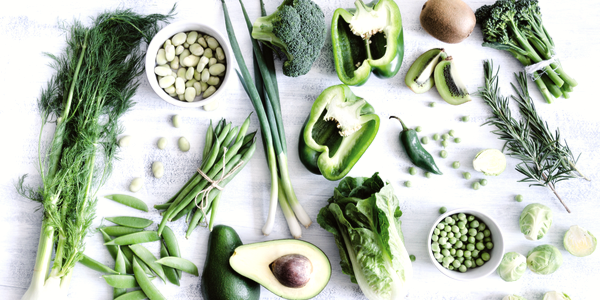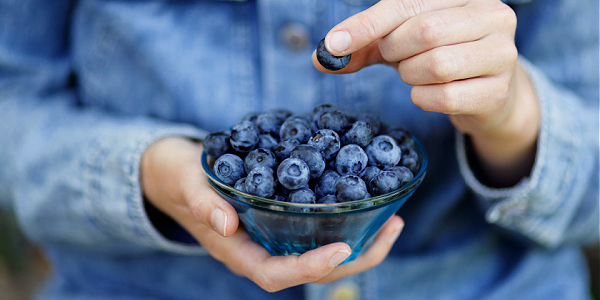
Kermit The Frog was right when he said, "It ain't easy being green." Eating green foods can sometimes feel like a chore, even though scientists continue to list the benefits. Healthy green vegetables, leafy greens, and other healthy green foods are linked to a reduced risk of many diseases.
Beyond getting greens to taste good, the mix of science and myth in the media today has many consumers confused. Are green beans good for you? Do green beans have potassium? What does spinach do for the body? What are the best greens to eat?
All these questions, and more, are answered in this article. Read on to learn about the top 16 tastiest green foods and what makes them so healthy!
Healthy Greens
Green foods often get a bad rap for being boring and unappetizing. With the recent rise of plant-based eating, green foods are being praised for the powerhouses they have always been.
While their whole, raw form is often the most nutritious, incorporating greens into the diet in any way can have amazing health benefits.
Well-Balanced for Weight Management
Vegetables and fruits that are green generally have a low amount of calories while maintaining a high level of essential nutrients. This benefits the body in many ways, but especially when it comes to managing weight.
Fantastic Sources of Fiber
According to the Dietary Guidelines for Americans 2020-2025, fiber is a dietary component of public health concern for the general U.S. population. This means that low intakes of fiber are associated with health concerns.
One key component of a healthy dietary pattern and one that meets dietary fiber needs is increasing vegetable, fruit, and beans intake. Green foods can help meet the needs of a healthy diet and decrease the risk of health concerns.
Important at Every Life Stage
From infants to adults to ages 60 and older, nutrients such as fiber, calcium, and potassium are of public health concern. While supplementation or fortification with these nutrients is possible, it is a good idea to try and get nutrients from food first.
Children as young as 6 months can begin eating green vegetables. These vegetables provide a plethora of nutrients, including protein and dietary fiber. Nutrient-rich green vegetables help with proper digestion, growth, development, and other body functions.
Whole Food
The whole, raw form of green foods is often the one with the most available nutrients. Incorporating whole foods into dietary practice can help increase health and wellness. For example, while 100% fruit juice without added sugars is a healthier counterpart to sugar-sweetened beverages, the whole fruit is the form that contains the most fiber.
Leafy Greens
Leafy greens, especially dark leafy greens, contain antioxidants and can lower chronic disease risk. While color is not always the most telling indicator of nutrient status, the dark leaves of greens mean more nutrient content. For example, romaine lettuce has nine times the level of vitamin A that iceberg lettuce has.
Nutrient-Rich
Vitamins and minerals are abundant in leafy greens. Nutrients such as the following are present in higher levels in leafy green vegetables:
• Beta carotene (helps to form vitamin A)
• Dietary Fiber
• Folate
• Lutein (protects the eyes)
• Vitamin K
Leafy greens contribute to good health from head to toe, quite literally. The nutrients listed above provide a range of benefits, from helping with vision in the eyes to supporting blood clotting and adding to bone health.
Not Just for Salads
Most people think "salad" when they hear leafy greens. Luckily, there are more options than a standard salad. Try these five ideas:
1. Mix and match: Leafy greens come in a variety of colors, textures, and flavors. Mix different greens together to create a deeper flavor profile while also upping the number of nutrients.
2. Versatile veggies: Someone who is new to leafy greens can start out with spinach, kale, or collard greens. These varieties are easy to cook and can be delicious as part of a main dish or appetizer. Simply add a bit of vegetable oil and sauté with spices like garlic, salt, or pepper.
3. Breakfast, soups, stews, casseroles, and beyond: Leafy greens do not have to be limited to salads or just eaten whole. They make a wonderful addition to many dishes. Try throwing them in some of the following recipes:
• Omelets
• Soups or stews
• Casseroles or baked dishes
• Baked chips (i.e. Kale chips)
• Smoothies
• Sandwiches
4. Add some healthy fats: Certain nutrients in leafy greens are better absorbed when accompanied by healthy fats. Homemade, healthy oil-based dressings can provide unsaturated fats. These fats help the body access fat-soluble vitamins such as vitamins A, D, and K.
5. Get to know your greens: While leafy greens share colors and characteristics, each variety provides a unique bite.
• Peppery flavor- arugula, watercress
• The type with a "bite"- chicory, escarole
• Mild, delicate flavor- mâche, Boston or Bibb lettuce
• Deep-green leaves- spinach, kale, collard greens, chard
• Crispy texture- romaine, iceberg
Green Vegetables
Contrary to popular belief, green vegetables can be both delicious and nutritious.
The following foods are nutrient powerhouses. This means they are rich in needed vitamins and minerals while keeping calorie levels low.
1. Kale
With one cup containing almost 700% of the Daily Value for vitamin K, Kale is considered an exceptional vegetable. Kale packs a nutrient-filled punch with levels of vitamins A and C also exceeding the Daily Value in just one cup.
This leafy green also contains lutein and beta carotene. Both of these components are key in reducing disease risk and squashing stress in the body. Experts recommend raw consumption for the highest amount of nutrients to be available.
2. Broccoli
A cruciferous vegetable that arms the body against constipation, broccoli is another green vegetable that seems to do it all. From heart disease to cancer, broccoli has been studied for boosting the body's antioxidant properties.
3. Collard Greens
A cousin of kale and cabbage, collard greens share the hue but have a slightly bitter taste and thickness to their leaves. Providing vitamins A, B9 (folate), C, and K, they seem to have an alphabet of nutrients contained in just one cup.
Think kale was impressive? Well, one cup of collard greens has over 1,000% of the Daily Value of vitamin K. Especially in the aging population, this green machine could add powerful properties to the body by reducing blood clots and improving bone health.
4. Celery
Six calories per stalk have made celery a classic diet food. However, full of fiber and armed with antioxidants, celery is much more than just a diet dish.
Paired with hummus or peanut butter, this versatile veggie can be used in a variety of ways. Try adding celery as a bulking agent to soups and salads.
5. Spinach
Known for its versatility, spinach is added to many dishes. From smoothies at breakfast to salads at lunch or soup for dinner, spinach provides increased amounts of folate.
Eating spinach is popular especially among pregnant populations, due to folate’s key role in preventing defects in the first trimester of pregnancy.
6. Arugula
Arugula is a low-calorie, high-nutrient green that can switch up a standard salad dish. Unique in taste, it has also been associated with special roles in heart, bone, and eye health. As a nutrient-rich vegetable, it can be a great option for weight loss and maintenance.
7. Asparagus
Available year-round, asparagus is a superstar green when it comes to fiber. As a stand-alone dish or part of another, it contains many vitamins and minerals, such as iron and copper.
8. Cucumbers
Cucumbers have an impressive water content, up to 96 percent water by weight. They contain a wide variety of benefits from plant compounds, including powerful anti-inflammatory properties.
9. Green Beans
Whether fresh green beans or from a can, this green veggie is nutrient-rich and can be easily seasoned to complement most dishes. They include many vitamins and minerals, such as protein, B vitamins, calcium, folic acid, and potassium.
10. Jalapenos
Peppers like the jalapeno are small but significant when it comes to nutrient content. While the spiciness comes from a compound called capsaicin (which is thought to have its own health benefits), jalapenos provide vitamins A and C to a variety of dishes.
Try tossing them in a soup, salad, chili, or salsa to spice things up.
11. Zucchini
This veggie looks like a cucumber but is actually the cousin of watermelon, both of which are water-rich foods. Zucchinis also provide potassium, B vitamins, vitamin C, and dietary fiber.
From boats to bread to brownies, zucchinis are enjoyed most often in their cooked form.
Green Fruit
Whether filled with natural sweetness or uniquely sourcing healthy fat, add these healthy green fruits to your list!
12. Honeydew
The honeydew melon is smooth-skinned with pale green flesh. With impressive levels of water, the honeydew is excellent at hydration. Antioxidants, vitamins, and minerals are just a few of the benefits honeydew supplies.
One cup of honeydew is only 64 calories, making it a great option for managing weight. Vitamins like folate, vitamin K, and minerals like magnesium are also found in higher levels in the honeydew melon. These nutrients are vital to keeping bones healthy and strong.
13. Avocados
Tropical as well as a top-notch source of healthy fat, avocados are a unique fruit. They are rich in omega-3 fatty acids, which are shown to protect against diseases such as arthritis, depression, Alzheimer's disease, and dementia.
Their creamy texture complements smoothies and desserts while providing a pleasant addition to salads or sandwiches.
14. Green Grapes
Grapes have been valued since ancient times, mostly for their use when it comes to making wine. One cup of green grapes is roughly 100 calories, and they contain high levels of several important nutrients.
High in antioxidants, green grapes can help protect against chronic disease and may even help lower cholesterol levels.
15. Granny Smith Apples
Full of fiber and other valuable nutrients, green Granny Smith Apples are good for far more than just apple pies. The tart crisp of this type of apple can help regulate bowel movements and control cholesterol levels.
Paired with something sweet-tasting, such as cinnamon, yogurt, or nut butter, this tart fruit can provide a surprisingly pleasant snack.
16. Kiwis
On the sweeter side, kiwis are also nutrient-rich and known for their fiber content. Vitamin C and potassium levels are also increased in kiwis, and they are thought to promote skin, heart, and digestive health.
Popular plates include fruit salads, yogurt parfaits, and smoothie bowls.
The Bottom Line
Green foods, especially leafy greens, contain much-needed nutrients. Many greens can be found year-round and are among some of the most versatile foods available.
Overall, adding greens to the diet can help protect against diseases like cancer, heart disease, inflammation, and beyond!
References:
Academy of Nutrition and Dietetics. Different Kinds of Lettuces and Greens. Eat Right. https://www.eatright.org/food/nutrition/healthy-eating/different-kinds-of-lettuces-and-greens. Published January 11, 2021.
Enloe A. The 13 Healthiest Leafy Green Vegetables. Healthline. https://www.healthline.com/nutrition/leafy-green-vegetables#:~:text=Leafy%20green%20vegetables%20are%20an,and%20mental%20decline%20(%201%20). Published July 1, 2018.
GRACE Communications Foundation. Melon. FoodPrint. https://foodprint.org/real-food/melons/. 2021.
GRACE Communications Foundation. Zucchini and Summer Squash. FoodPrint. https://foodprint.org/real-food/zucchini-and-summer-squash/. 2021.
Groves M. Top 12 Health Benefits of Eating Grapes. Healthline. https://www.healthline.com/nutrition/benefits-of-grapes. Published August 22, 2018.
Hill A. 10 Surprising Benefits of Honeydew Melon. Healthline. https://www.healthline.com/nutrition/honeydew. Published November 28, 2018.
USDA Department of Health and Human Services. Dietary Guidelines for Americans 2020-2025. https://www.dietaryguidelines.gov/sites/default/files/2020-12/Dietary_Guidelines_for_Americans_2020-2025.pdf. Published December 29, 2020.





